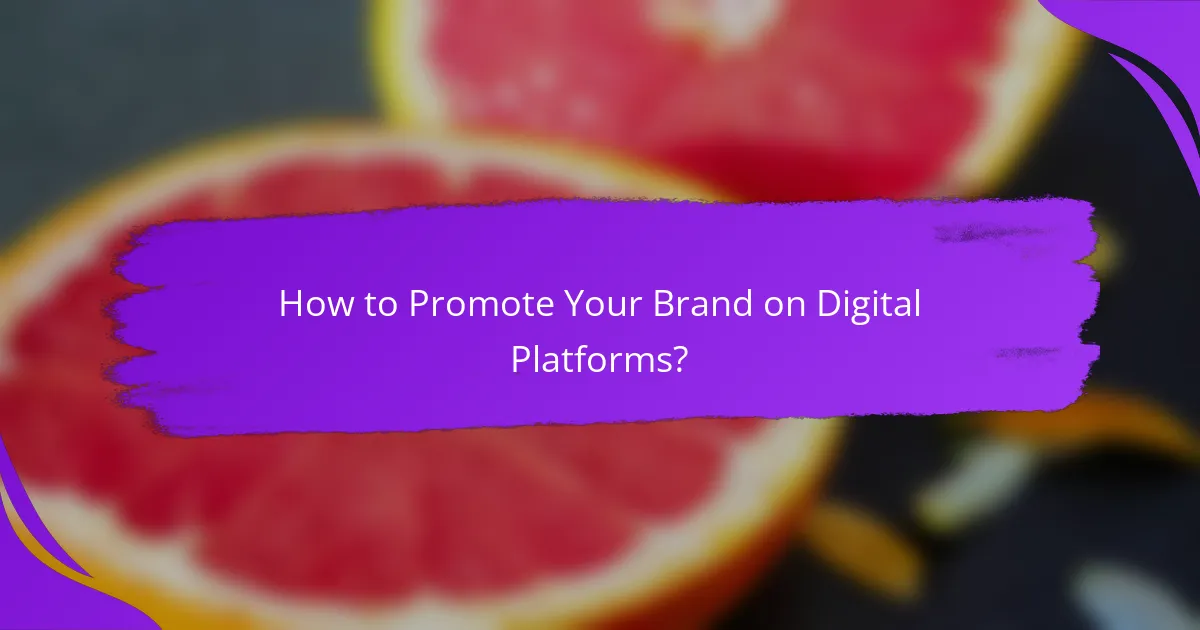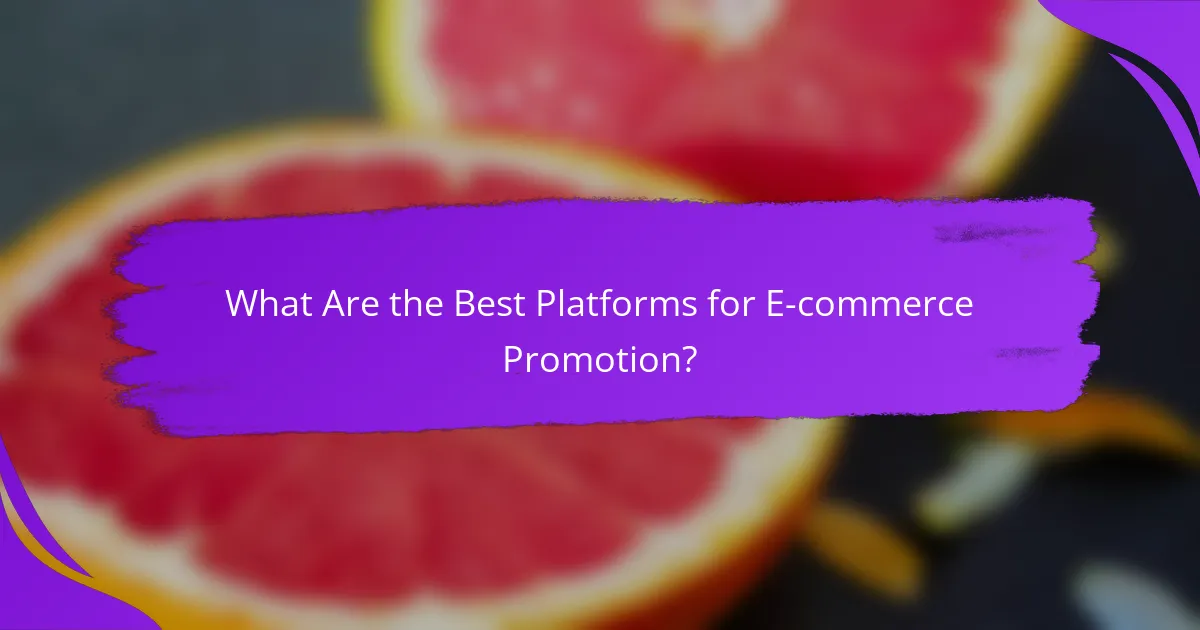In today’s digital landscape, promoting your brand effectively requires a strategic approach that utilizes various online channels to boost visibility and engagement. By implementing targeted strategies such as social media advertising and content marketing, brands can create meaningful interactions with users, enhancing their overall experience and fostering loyalty. Additionally, measuring reach is crucial for evaluating the success of these promotional efforts and understanding audience engagement.

How to Promote Your Brand on Digital Platforms?
Promoting your brand on digital platforms involves leveraging various online channels to increase visibility and engagement. Effective strategies include social media advertising, email marketing, influencer partnerships, content marketing, and search engine marketing.
Social Media Advertising
Social media advertising allows brands to reach targeted audiences through platforms like Facebook, Instagram, and Twitter. Advertisers can create tailored ads based on user demographics, interests, and behaviors, maximizing the chances of engagement.
Consider setting a budget that aligns with your goals, whether it’s brand awareness or direct sales. Start with small campaigns to test different ad formats and messages, then scale up based on performance metrics.
Email Marketing Campaigns
Email marketing campaigns are a direct way to communicate with your audience, offering personalized content and promotions. Building a quality email list is crucial; focus on collecting addresses through website sign-ups and social media incentives.
Segment your audience to send targeted messages that resonate with different groups. Aim for a clear call to action in each email and monitor open and click-through rates to refine your approach over time.
Influencer Partnerships
Influencer partnerships involve collaborating with individuals who have a significant following on social media or blogs. These influencers can help amplify your brand’s message and reach new audiences authentically.
Choose influencers whose values align with your brand and whose audience matches your target market. Establish clear expectations regarding deliverables and compensation, and track the effectiveness of the partnership through engagement metrics.
Content Marketing Strategies
Content marketing strategies focus on creating valuable content to attract and engage your audience. This can include blog posts, videos, infographics, and podcasts that provide information or entertainment relevant to your brand.
Consistency is key; develop a content calendar to ensure regular updates. Utilize SEO best practices to enhance visibility in search engines, and promote your content across social media to drive traffic back to your website.
Search Engine Marketing
Search engine marketing (SEM) involves using paid advertising to appear in search engine results. This strategy can quickly increase visibility for specific keywords relevant to your business.
Set clear objectives for your SEM campaigns, such as increasing website traffic or generating leads. Monitor performance closely and adjust bids and keywords based on what drives the best results, keeping an eye on your return on investment (ROI).

What Engagement Strategies Work Best?
Effective engagement strategies focus on creating meaningful interactions with users, enhancing their experience, and fostering loyalty. Key approaches include interactive content, live streaming events, community building initiatives, and personalized user experiences.
Interactive Content
Interactive content, such as quizzes, polls, and surveys, encourages users to actively participate rather than passively consume information. This type of content can significantly boost engagement rates, as it invites users to share their opinions and experiences.
To implement interactive content effectively, consider using tools that allow easy integration into your platform. For instance, embedding a quiz related to your product can lead to higher user retention and sharing rates.
Live Streaming Events
Live streaming events provide real-time interaction between brands and their audience, creating a sense of immediacy and connection. These events can include product launches, Q&A sessions, or behind-the-scenes looks at your company.
To maximize the impact of live streaming, promote the event in advance across your digital channels. Engaging with viewers through comments and questions during the stream can enhance the experience and encourage participation.
Community Building Initiatives
Building a community around your brand fosters loyalty and encourages user-generated content. Initiatives such as forums, social media groups, or membership programs can create a sense of belonging among users.
Consider hosting regular discussions or challenges that encourage community interaction. This not only keeps users engaged but also provides valuable feedback and insights into their preferences and needs.
Personalized User Experiences
Personalization tailors the user experience based on individual preferences and behaviors, making interactions more relevant and engaging. This can include personalized recommendations, targeted emails, or customized content based on user activity.
To implement effective personalization, utilize data analytics to understand user behavior and preferences. However, ensure compliance with data protection regulations, such as GDPR, to maintain user trust and privacy.

How to Measure Reach on Digital Platforms?
Measuring reach on digital platforms involves tracking how many unique users have interacted with your content over a specific period. This metric helps assess the effectiveness of your promotional strategies and audience engagement efforts.
Analytics Tools Overview
Analytics tools provide essential data for measuring reach, offering insights into user interactions across various digital platforms. Popular tools include Google Analytics, Facebook Insights, and Twitter Analytics, each designed to track different aspects of user engagement.
When selecting an analytics tool, consider factors such as ease of use, integration capabilities, and the specific metrics you want to track. Most platforms offer free versions with basic features, while premium options provide advanced analytics for a fee.
Key Performance Indicators (KPIs)
Key Performance Indicators (KPIs) are critical for evaluating reach on digital platforms. Common KPIs include unique visitors, impressions, engagement rate, and click-through rate (CTR). These metrics help you understand how well your content is resonating with your audience.
Establish clear goals for each KPI to measure success effectively. For instance, aim for a specific percentage increase in unique visitors over a quarter or a targeted CTR for a particular campaign. Regularly reviewing these KPIs allows for timely adjustments to your strategies.
Audience Insights and Demographics
Understanding audience insights and demographics is vital for measuring reach effectively. This data reveals who is engaging with your content, including age, gender, location, and interests, which can inform your marketing strategies.
Utilize analytics tools to segment your audience and identify trends. For example, if a significant portion of your audience is located in a specific region, consider tailoring your content or promotional efforts to resonate more with that demographic. Regularly updating your audience insights ensures your strategies remain relevant and effective.

What Are the Best Platforms for E-commerce Promotion?
The best platforms for e-commerce promotion include social media networks and visual discovery tools that facilitate product visibility and customer engagement. Key platforms like Facebook, Instagram, and Pinterest offer unique features tailored to enhance online sales and customer interaction.
Facebook for E-commerce
Facebook is a powerful tool for e-commerce promotion, allowing businesses to create targeted ads and engage with potential customers through posts and groups. With over two billion active users, brands can reach specific demographics based on interests, behaviors, and location.
Utilizing Facebook Shops enables businesses to set up a storefront directly on their page, making it easy for users to browse and purchase products without leaving the platform. Regularly posting engaging content and utilizing Facebook Live can further enhance customer interaction and drive sales.
Instagram Shopping Features
Instagram offers robust shopping features that allow businesses to tag products in posts and stories, making it easy for users to shop directly from their feeds. The platform’s visual nature is ideal for showcasing products, especially in fashion, beauty, and home decor sectors.
Brands can create an Instagram Shop, where users can browse all available products in one place. Utilizing high-quality images, engaging captions, and influencer partnerships can significantly boost visibility and conversion rates.
Pinterest for Product Discovery
Pinterest serves as a visual discovery platform where users seek inspiration for purchases, making it ideal for e-commerce promotion. Businesses can create visually appealing pins that link directly to product pages, driving traffic and potential sales.
Using Rich Pins enhances product visibility by providing real-time pricing and availability information. Brands should focus on creating eye-catching images and utilizing keywords effectively to improve searchability on the platform.

What Criteria Should You Consider When Choosing a Digital Platform?
When selecting a digital platform, consider factors such as your target audience, the platform’s features, and its potential for engagement and reach. These criteria will help ensure that the platform aligns with your goals and effectively connects with your intended users.
Target Audience Alignment
Aligning your chosen digital platform with your target audience is crucial for effective engagement. Understand who your audience is, including their demographics, interests, and online behaviors. This knowledge will guide you in selecting a platform that resonates with them.
For example, if your target audience consists of younger users, platforms like TikTok or Instagram may be more effective than LinkedIn. Conversely, for a professional audience, LinkedIn would be a better fit. Consider where your audience spends their time and what type of content they prefer.
To assess alignment, create a checklist of your audience’s characteristics and compare them with the platform’s user base. Look for platforms that not only attract your audience but also support the content formats they engage with, such as video, articles, or images.


